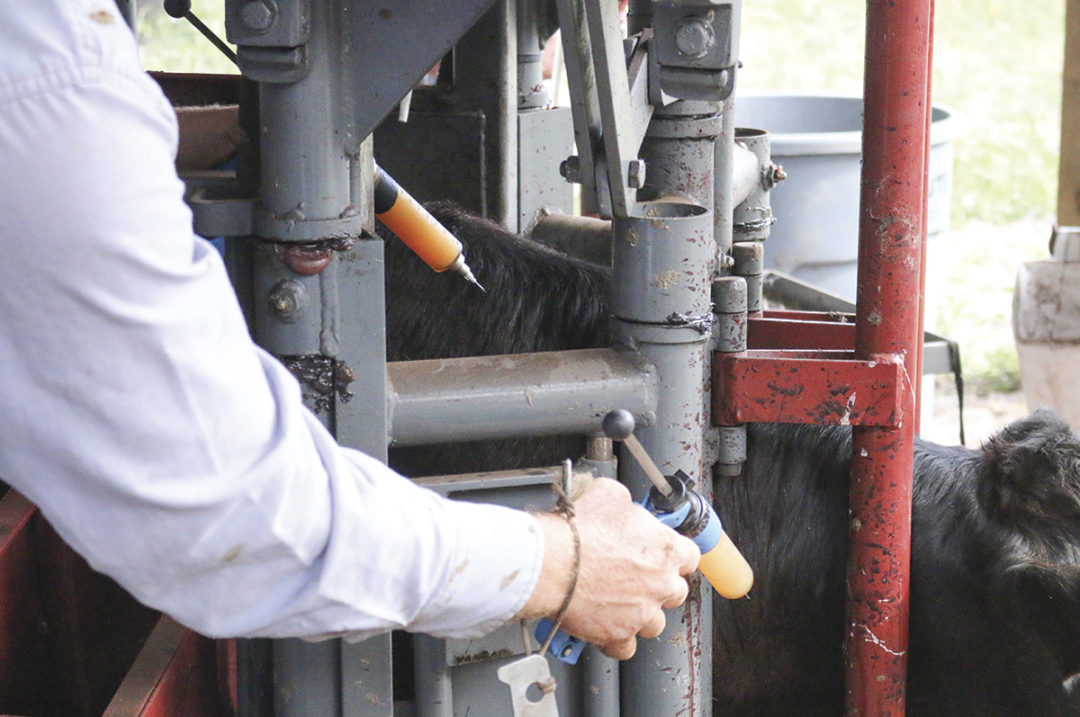Vaccine products administered to cattle are foreign to the animal’s body. The goal is for the body to recognize these foreign organisms and develop an immune response for protection in the event of a future disease challenge. On occasion, the vaccine can cause an adverse reaction to occur in the animal. Adverse reactions can range in severity from mild temporary lumps and bumps to sudden systemic anaphylactic shock with fluid accumulation in the lungs and death.
There are several predisposing factors and causes of adverse reactions including genetics of the cattle, vaccine adjuvants, type of organisms in the vaccine, nutrition and how the vaccine is handled or administered. This article will review and discuss the factors associated with vaccine adverse reactions, how to minimize the lumps and bumps, and what to do if a minor or serious adverse event occurs.
What is an adverse reaction?
The Center for Veterinary Biologics (CVB) is the branch of the USDA that regulates cattle biologics or vaccines whether the vaccine is a commercially available product or a custom autogenous vaccine. The CVB’s definition of an adverse event is any undesirable occurrence after the use of an immunobiological product, including illness or reaction, whether or not the event was caused by the product. This means that not only lumps, bumps or death are adverse reactions, but so are instances when vaccines fail to protect against the diseases the vaccine is labeled for. An example of an adverse event due to lack of efficacy would be calves vaccinated for pasteurella pneumonia but that still get pneumonia due to a pasteurella bacterial infection. Lack of efficacy is an adverse event even if it is not the fault of the vaccine, such as cattle becoming ill due to the stress of weaning, transport, mismanagement or inclement weather.
Any adverse events should be reported to your veterinarian or contact the vaccine manufacturer. Vaccine manufacturers are required to notify the CVB of all adverse event reports received from producers and veterinarians. Be sure to record the serial numbers of vaccines used or keep one empty bottle of each type until the danger of adverse events has passed. This is very important information for the manufacturer to follow up on adverse events.
Types of adverse reactions
Swelling or lumps at the injection site are the most common type of adverse reaction. Lumps can be transient, lasting a few days, or permanent. Some lumps can develop into abscesses, which may progress into large and painful lesions. Lumps are most often due to a reaction by the animal to the carriers, or adjuvants incorporated into the vaccine. Lumps can also be caused by the use of dirty needles or the use of contaminated vaccines. Multidose vaccine vials can become contaminated by penetration with dirty needles when refilling multidose syringes. To reduce this risk, always use a new clean needle when entering a multidose vial. It is recommended that partially used bottles are discarded at the end of the day rather than returned to the refrigerator, due to the high risk of contamination of the bottle contents while being used.
Hives are an uncommon type of adverse reaction in cattle. Post-vaccination hives in horses are a much more common occurrence. The clinical signs of hives are numerous 0.25- to 1.5-inch raised bumps on the skin that are pruritic (itchy). Hives are the result of the degranulation of mast cells and the subsequent release of histamine and other inflammatory compounds into the dermal layer of the skin. Histamine release can produce many different effects within the body including the constriction of the airways of the lungs and the dilation of blood vessels, which increases blood vessel permeability, lowers blood pressure and causes dermal edema.
Anaphylaxis is the most serious type of adverse reaction. It is a potentially fatal condition and is a medical emergency that requires immediate attention. The clinical signs of anaphylaxis often occur within 10 to 20 minutes after vaccination but can be seen even several hours later. The earliest signs typically include difficulty breathing, muscle tremors and restlessness. The animal may exhibit swelling around the face, excessive salivation and tearing of the eyes, drooping ears, collapse and death. When possible, an autopsy should be performed on dead animals to rule out other causes of death.
Breed and environmental factors
There are indications that dairy breeds may experience higher incidences of anaphylaxis than occur in beef breeds. The generally accepted guidelines for vaccinating dairy breeds are different than those guidelines for beef breeds; more on this is discussed in the section below on vaccine endotoxins. There is also information that certain genetic lines of beef cattle experience anaphylaxis more frequently than other genetic lines of beef cattle. Evidence also suggests reactions may be more likely to occur during hot weather.
Effect of vaccine composition
Vaccines can contain either attenuated modified-live virus (MLV), inactivated killed organisms, a combination of both MLV and killed organisms, or subunit and toxoid vaccines, which contain only microbial proteins. MLV vaccines contain organisms that have been modified by the manufacturer to not cause clinical disease, but the organisms are still able to replicate in the animal and stimulate immunity after vaccination. MLV vaccines must replicate in the animal to stimulate an immune response and ensure maximal efficacy. If MLV vaccines are mishandled either by improper storage, such as becoming too hot or freezing before administration, then the organisms may perish and not replicate after administration, and a reduced or incomplete immune response can occur. A common adverse reaction seen with MLV vaccines containing infectious bovine rhinotracheitis (IBR) is abortion when administered to unvaccinated pregnant heifers or cows. Some but not all IBR MLV vaccines are safe to use in pregnant animals; it is critical to follow the manufacturers' label direction in these cases.
Inactivated or killed vaccines are generally presumed to be a safer alternative to MLV vaccines, but many times that is not the case. Often the most severe adverse reactions occur with killed vaccine usage. Killed vaccines contain adjuvants, which are compounds added to a vaccine to improve the immunogenicity of the vaccine. Killed vaccines usually produce a lesser immune response than their MLV vaccine equivalents; adjuvants are used to overcome this effect.
Another consideration is the type of organisms in the vaccine. Vaccines can contain viruses, bacteria or other types of agents. For example, gram-negative bacterial vaccines can contain endotoxin, which can cause anaphylaxis when present in high levels, whereas gram-positive bacterial vaccines do not contain endotoxin. Gram-negative organisms that may be in a vaccine include: moraxella (pinkeye), mannheimia, pasteurella, histophilus (respiratory), brucella, E. coli (scours) and leptospira species. Endotoxins have a direct effect on the cardiovascular, respiratory and central nervous systems. The signs of endotoxic shock are increased respiratory rate, collapse and possibly death. The clostridial bacteria that are found in the 7- and 8-way vaccines are gram-positive; clostridial vaccines do not contain endotoxin, but they do frequently cause injection site lumps due to the adjuvant in the vaccine. Commercial and autogenous vaccines are tested for safety when manufactured, but if mishandled by freezing or being exposed to high temperatures, the gram-negative bacteria in a vaccine can be damaged, causing the bacteria to release endotoxin and making the vaccine unsafe to use.
Impact of nutrition on adverse reactions
The proper function of the immune system is highly dependent on the availability of adequate nutrition, not only energy and protein but also macro- and trace minerals. Nutritional deficiencies can result in the vaccine not providing the protection expected. A poor immune response to vaccination can be expected when cattle are on diets deficient in energy, protein or trace minerals, or when cattle are off-feed due to stress. Sick cattle go off feed, and the normal trace mineral, energy and protein intake can drop quickly due to reduced feed intake and increased immune system requirements. Lack of vaccine protection is an adverse event.
Some researchers have observed an increase in post-vaccination injection site lesions in copper-deficient cattle; this is believed to be due to a decrease in the stability of the mast cells and an increase in histamine release in copper-deficient cattle.
Recommendations for minimizing vaccine reactions
Any vaccine can cause an adverse reaction. Remember that endotoxin can be present in any vaccine containing a gram-negative organism, and most bacterial vaccines used in cattle are gram-negative. Adjuvants that can cause adverse reactions can be found in any vaccine; gram-negative or gram-positive, modified-live or inactivated (killed).
Always:
- Use vaccines according to label directions, including adhering to the label route of administration, expiration date and recommended minimum age of the animal for vaccination.
- Be aware and cautious of the total number of gram-negative vaccines given at any one time (called “endotoxin stacking”) and be aware of the differences in endotoxin sensitivities of the different breeds of cattle, especially dairy breeds. Consult your veterinarian to ensure your vaccine protocol does not place your animals at risk for endotoxin stacking.
- Keep vaccines properly cooled and in dark conditions. Do not allow vaccines to freeze or get hot, which might cause cell rupture and endotoxin release or unintentionally kill modified-live organisms. This is true not only for long-term storage, but also for transport of vaccines to the worksite and holding vaccines temporarily during a long day of vaccinating. Anything that disrupts the integrity of the cell wall can result in the release of endotoxin.
- Choose a needle gauge (diameter) that is sufficient for the viscosity of the vaccine product but no larger than necessary. Needle length should vary depending on whether the vaccine is intended for subcutaneous (SQ) or intramuscular (IM) administration. Most SQ vaccinations should occur in the lower neck region, targeting the soft pocket of flesh ahead of the shoulder. Depending on animal age, a half-inch to three-quarter-inch needle is usually long enough to enter the SQ space without hitting the muscle. Change needles frequently to keep them sharp and free from contamination. Never introduce a used needle back into the vaccine bottle.
Treating adverse reactions
If the adverse reaction is a small lump, many will be temporary and resolve without the need for treatment. However, if the lump does not resolve within a few days, is large, warm to the touch or is painful enough to restrict grazing or eating from a bunk, then lancing and flushing the abscess may be indicated. Treatment with systemic antibiotics is not indicated nor effective for the treatment of abscesses.
Mild cases of hives may spontaneously resolve within 12 to 48 hours. Cattle with more severe cases of hives may benefit from treatment with a steroid or antihistamine. Use caution if a steroid is used as steroids can cause abortion in pregnant females. Always follow your veterinarian’s advice any time you observe cattle experiencing an adverse reaction or when you need advice regarding additional supportive therapy.
Anaphylaxis and anaphylactic shock are a veterinary emergency and must be treated as soon as possible. As soon as clinical signs of anaphylaxis are noticed, the treatment is the immediate use of IV epinephrine. Alternatively, some vaccines have label instructions that call for administration of flunixin in the event of systemic reactions. If administering an IV injection is not possible, then SQ or IM injections should be used. Epinephrine should be kept in the cooler box with the vaccine at the location where the cattle are being processed; there is no time to go back to the barn or drug room to look for epinephrine during an anaphylactic emergency. Consult with your veterinarian as to their recommended dosage and availability of epinephrine.






